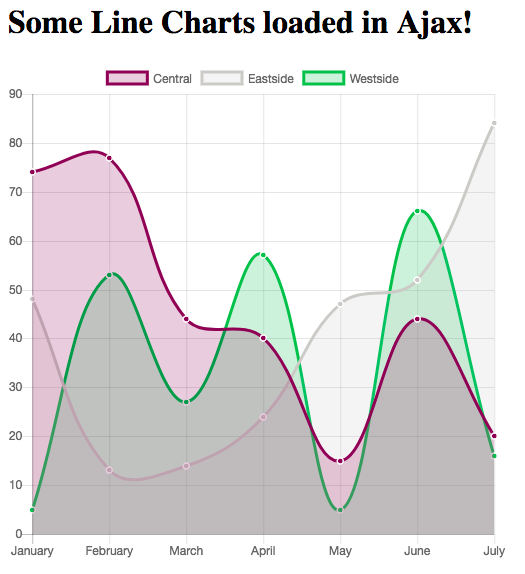Django Chartjs lets you manage charts in your Django application.
This is compatible with Chart.js and Highcharts JS librairies.
Using a set of predefined Class Based Views you are able to get started after writing just your SQL query.
- Authors: Rémy Hubscher and contributors
- Licence: BSD
- Compatibility: Django 1.5+, python2.7 up to python3.3
- Project URL: https://github.com/novagile/django-chartjs
Install django-chartjs:
pip install django-chartjsAdd it to your INSTALLED_APPS settings:
INSTALLED_APPS = (
'...',
'chartjs',
)A simple Line Chart example.
{% load staticfiles %}
<html>
<head>
<title>django-chartjs line chart demo</title>
<!--[if lte IE 8]>
<script src="{% static 'js/excanvas.js' %}"></script>
<![endif]-->
</head>
<body>
<h1>Some Line Charts loaded in Ajax!</h1>
<canvas id="myChart" width="500" height="400"></canvas>
<script type="text/javascript" src="http://code.jquery.com/jquery-1.10.0.min.js"></script>
<script type="text/javascript" src="{% static 'js/Chart.min.js' %}"></script>
<script type="text/javascript">
$.get('{% url "line_chart_json" %}', function(data) {
var ctx = $("#myChart").get(0).getContext("2d");
new Chart(ctx).Line(data);
});
</script>
</body>
</html>from random import randint
from django.views.generic import TemplateView
from chartjs.views.lines import BaseLineChartView
class LineChartJSONView(BaseLineChartView):
def get_labels(self):
"""Return 7 labels."""
return ["January", "February", "March", "April", "May", "June", "July"]
def get_data(self):
"""Return 3 datasets to plot."""
return [[75, 44, 92, 11, 44, 95, 35],
[41, 92, 18, 3, 73, 87, 92],
[87, 21, 94, 3, 90, 13, 65]]
line_chart = TemplateView.as_view(template_name='line_chart.html')
line_chart_json = LineChartJSONView.as_view()It is that simple!
For other examples, don't hesitate to look at the demo project.
Also, feel free to contribute your demo!





